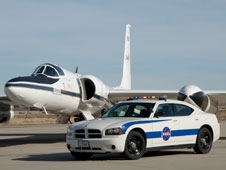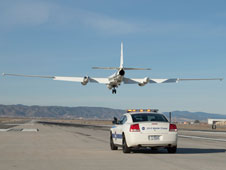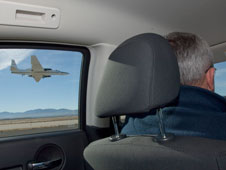 Employees at Air Force Plant 42 in
Employees at Air Force Plant 42 in
Employees
at Air Force Plant 42 in

NASA’s ER-2 high-altitude research aircraft is
guided to a safe and smooth landing by voice commands radioed from an ER-2
mobile pilot driving a NASA Dodge Charger chase vehicle. The aircraft and its
chase car are based at NASA’s Dryden Aircraft Operations Facility in Palmdale,
Calif. (NASA Photo / Tony Landis)
The
aircraft is a NASA ER-2, a civilian version of the Air Force's high-altitude
U-2S. Based at NASA’s Dryden Aircraft Operations Facility in Palmdale, the two
ER-2s have flown for the agency since the 1980s, conducting Earth science
research.
Landing an
ER-2 can be tricky. Its wings give the aircraft glider-like qualities and the
aircraft is sensitive to crosswinds. Both the ascent and descent rates are fast
and steep. Moreover, even normal operations in the ER-2 are difficult for the
pilot encased in a pressure suit.
This is where the white Charger comes
in. The 2010-model car, driven by another experienced ER-2 pilot called a mobile
pilot, literally "charges" down the runway in high-speed chase of the ER-2.
Communicating with the aircraft pilot, the mobile pilot calls out the distance
in feet from the landing gear to the runway in an effort to help the pilot make
a smooth landing.

As one of NASA's ER-2 high-altitude
science aircraft descends toward the runway, mobile pilot Jan Nystrom
accelerates NASA's Dodge Charger safety chase vehicle after it. The mobile pilot
follows the aircraft to landing, calling out the proximity to the ground from
wheels to runway to the aircraft pilot. (NASA Photo / Tony
Landis)
The Charger allows the mobile pilot to support the ER-2 pilot during all ground operations. His timely calls to the ER-2 pilot can make the difference in avoiding a mishap – whether it is from a ground taxi obstacle, hung pogo (auxiliary wheels) on takeoff, excessive crosswinds, engine malfunction or hydraulic failure.
"A chase vehicle has been historically proven to make the difference between a mishap and no mishap," said NASA ER-2 lead pilot Tim Williams.
NASA Dryden's Airborne Science program has leased the government-owned Charger for five years. The Charger has a standard police package – tires, engine and spotlights – while Dryden technicians added a light bar and aircraft radios.
"The Charger has added an extra value of safety when conducting our ER-2 flight operations," added Robert Navarro, NASA Dryden's ER-2 project manager.

 Previous page
Previous page Back to top
Back to top







